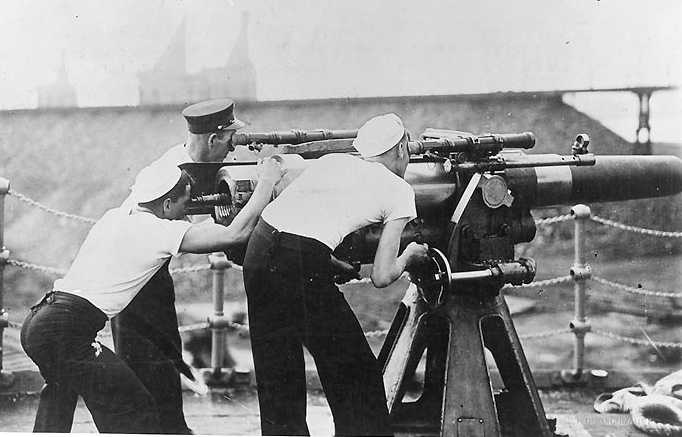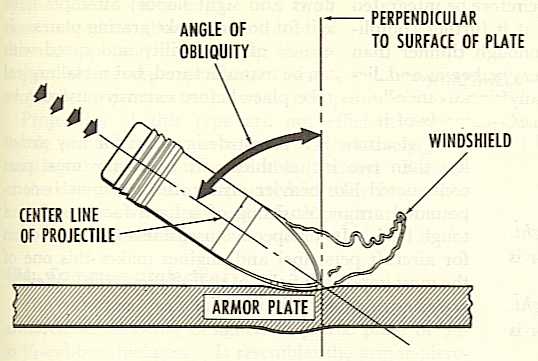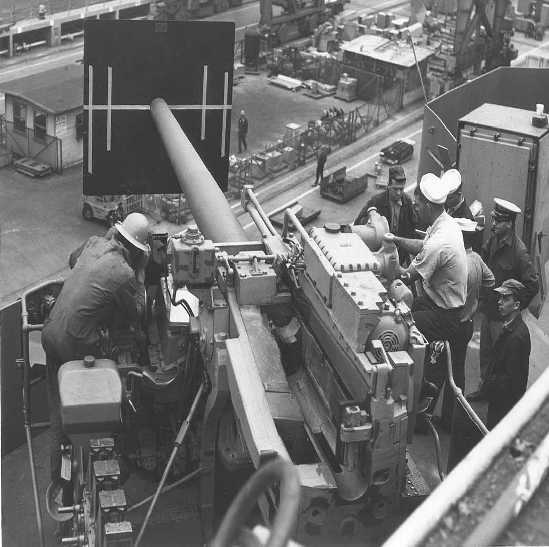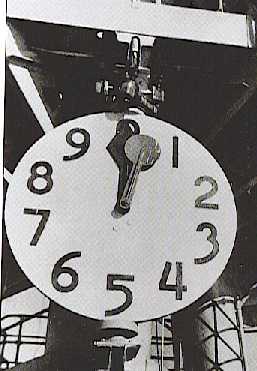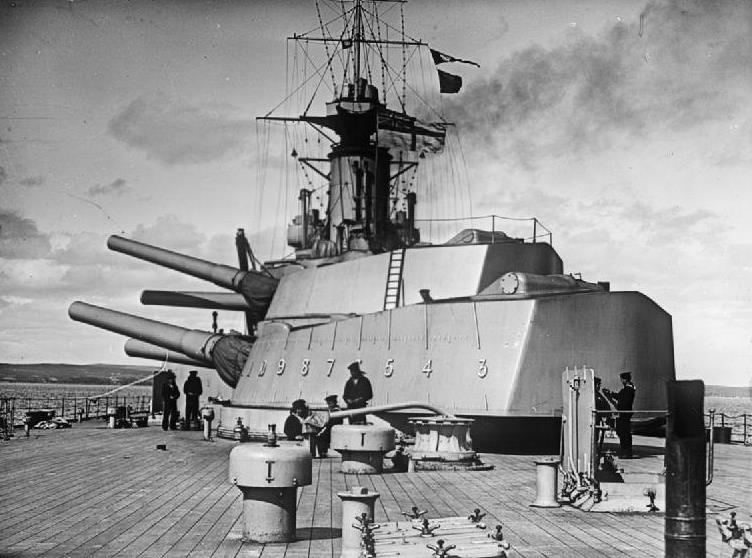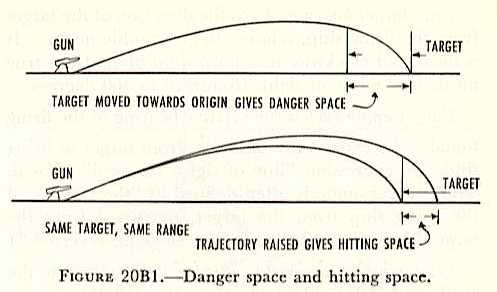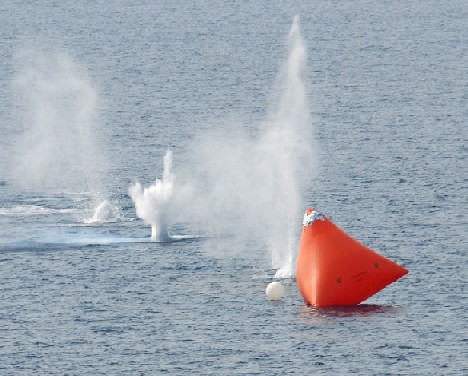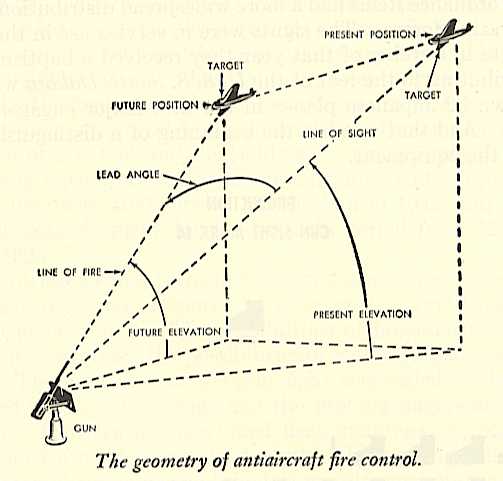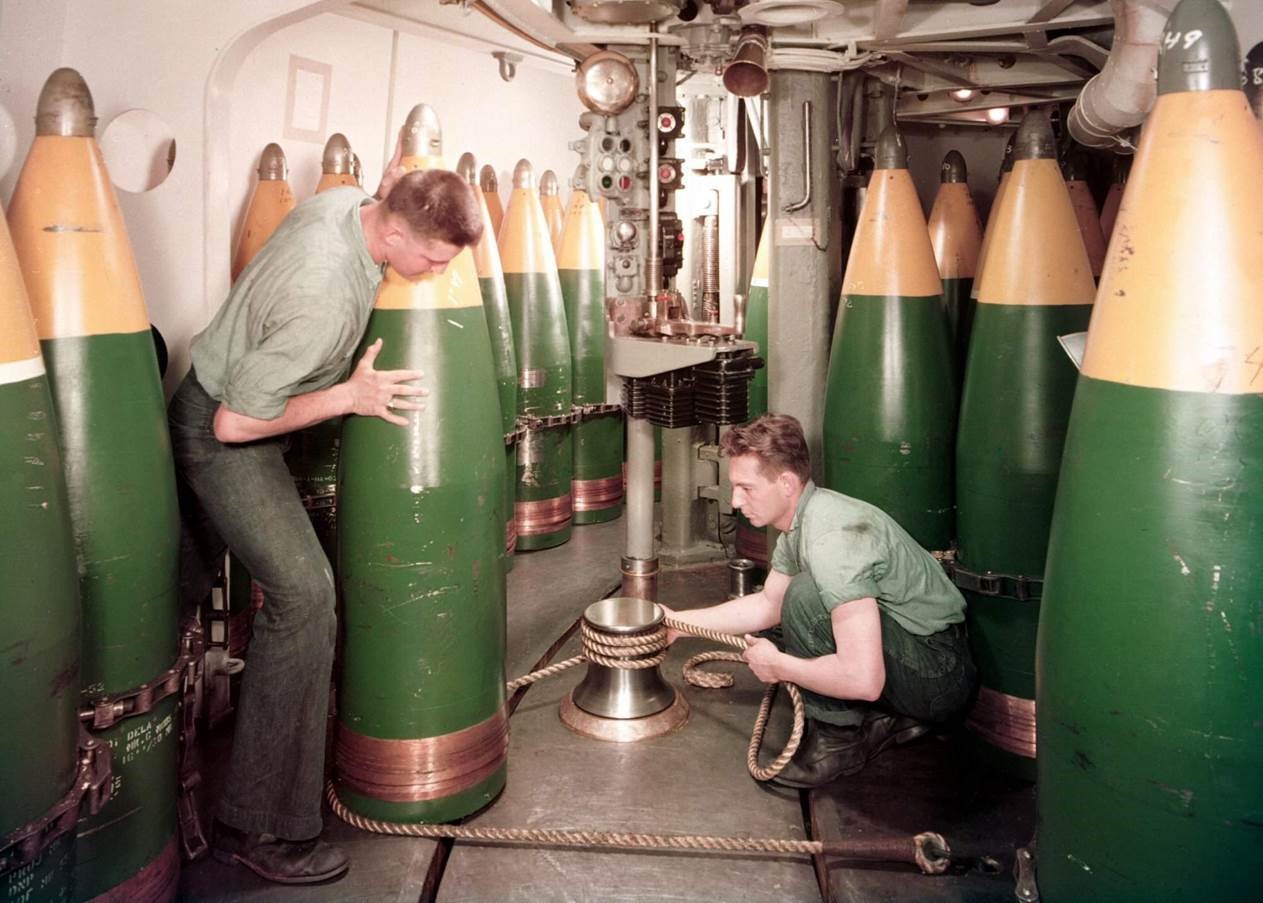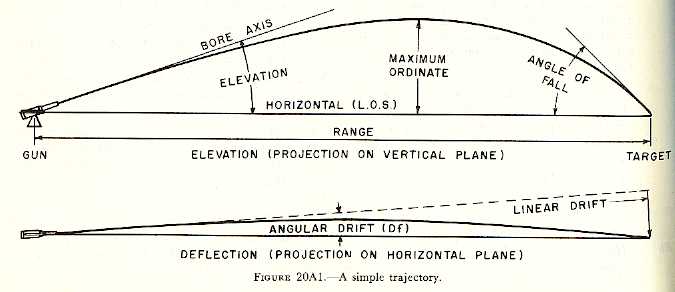AAA - Anti-Aircraft Artillery. Generally, any AA weapon with a bore larger than about 2.5 inches (6.4 cm).
AAW - Anti-Aircraft Warfare or Anti-Aircraft Weapon.
All Burnt - The point during a projectile's travel up the gun barrel where all of the propellant charge has been consumed. In most instances, propellant charges are designed such that the propellant has been consumed by the time that the projectile is about one half to two thirds of the way up the barrel. For example, the standard charge in a 5"/54 (12.7 cm) Mark 67 cartridge achieves All Burnt between 115 to 125 inches (290 to 320 cm) of shot travel, depending upon the amount of propellant loaded in the lot of charges being fired. Shot travel in the 5"/54 is 235 inches (597 cm), which means that the All Burnt point is about half-way up the barrel. There are a few exceptions where the All Burnt point is further up the barrel, but these are usually for rounds developed after the gun entered service where the charge developers are trying to obtain the highest possible muzzle velocity.
All Steel - A British term of the 1930s and 1940s used to describe guns built primarily from forged castings. This term was used to distinguish these new weapons from older guns built using wire winding techniques. The first large caliber British "all steel" gun was the 12"/50 (30.5 cm) Mark XIV, which was an experimental weapon completed in August 1933 to test the new construction techniques. The successful completion of these tests led to the same techniques being used to construct the 14"/45 (36.6 cm) Mark VII guns used on the King George V class battleships. It should be noted that wire-wound guns built for the Royal Navy had Wire engraved on their breeches while all-steel guns had Steel engraved on their breeches.
ASuW - Anti-Surface [ship] Warfare or Anti-Surface Weapon.
ASW - Anti-Submarine Warfare or Anti-Submarine Weapon.
Automatic vs. Semi-Automatic vs. Manual Firing - Automatic firing means that as long as the trigger or firing switch is closed, the gun will continue to pump out rounds. An example of this would be a machine-gun. Semi-Automatic means that the trigger or firing switch must be cycled for each shell fired, but that all shell handling operations are performed without manual intervention. An example of this operation would be a magazine fed pistol. Manual means that each individual shell must be handled and rammed into the breech by the gun crew in order to fire. An example of this would be a single-shot bolt action rifle. A "semi-automatic" breech is one in which the breech mechanism closes by itself when the round is rammed and then opens and ejects the shell casing automatically after the weapon fires.
Battery
1) A weapon is said to be "in battery"
when it is at rest in its mounting, ready for firing. This term comes
from the days of muzzle loading cannon where the gun was fired and was
allowed to recoil back far enough such that it could be swabbed, loaded,
rammed and then moved forward back into firing position or "returned to
battery." See "run out," below.
2) All of the guns of a specific caliber
on a particular ship. For example, the term "Main Battery" for USS
Iowa BB-61 refers to her nine 16-inch (40.64 cm) cannons while the term
"Secondary Battery" refers to her 5 inch (12.7 cm) guns.
3) All weapons that can be trained on
a particular target regardless of their caliber, as in the phrase "a battery
of weapons."
BCW - Biological, Chemical Warfare.
Biting Angle - The maximum angle of obliquity where an AP projectile will penetrate an armor plate rather than ricocheting.
Blowback
1) Unintended escape, to the rear and
under pressure, of the propellant gasses. Blowback may be caused
by a defective breech mechanism, a ruptured cartridge or a faulty primer.
2) Gasses formed by burning propellant
which are used to cycle the breech mechanism of gas-operated automatic
weapons.
Bore Premature - An explosive projectile detonating prior to leaving the gun barrel.
Bore Sighting - Aligning the bore of a gun with the gunsights. For guns that operate only in local control, this is usually achieved by first inserting a bore telescope into the breech of the weapon, as can be seen in the photograph at right. The bore sight is adjusted such that its cross hairs are exactly aligned with cross hairs that have been attached to the muzzle. The gun is then aimed until the bore sight is centered on a point target, preferably one that is at a similar distance where the gun would be most effective. The gun sights are then adjusted until they are centered on the same target point. See "Batten Board" below.
Bracket - A succession of two salvos, one over and one short or one left and one right, with no straddles.
Bracket Salvo - A method used to determine the range to a target. This procedure was extensively used by the German Navy in both World Wars. As used by the Germans, three half salvos were fired. The first half salvo was fired at the range determined by the rangefinder, the second at a range 400 meters too long and the third at a range 400 meters too short. By seeing which half salvo lands closest to the target, the actual range and bearing can be determined.
Broadside - Firing in a single salvo all guns that can bear on an abeam target. This may involve more than one caliber of weapons.
Chase Hooped - A method of strengthening weak gun barrels. Basically, this involves shrinking on additional hoops over the chase of a gun barrel.
Chicago Piano - Originally in the 1920s and 1930s, this was a slang term referring to the Thompson 0.45 caliber sub-machine gun, supposedly the weapon of choice of Chicago gangsters. During World War II, this was then used as a nickname often applied to almost any multi-barreled AA gun, most commonly to the British 2-pdr, British quad 0.50" and USN 1.1" AA guns. In the book "Whispering Death" by Lee Heide, there is a mention of a German naval AA weapon with this nickname, but the internal information in this book would lead me to believe that this was actually the Italian 37 mm AA gun.
Clip - A length of metal which holds several rounds together for feeding into a weapon. The rounds are usually stripped off the clip by the bolt as it cycles.
Cold Gun Correction - Refers to a correction for range for the first shots from a gun. The first few rounds from a gun fall slightly short due to the reduced friction caused by the oil used to swab the bore to keep it from rusting. This reduced friction allows the projectile to move forward at a lower pressure than what occurs in a clean, dry bore, and this lower pressure results in a lower muzzle velocity. Fire control systems have a built-in adjustment for this condition.
Davis Gun - During World War I, the USN conducted a series of experiments in mounting larger caliber guns on patrol aircraft for anti-submarine use. The "Davis non-recoil Guns" were 6-pdr (57 mm) and 3" (7.62 cm) weapons having two barrels. The first barrel faced forward and fired a standard projectile while the second barrel faced directly backwards and fired bird shot or buckshot. The weapon fired both barrels simultaneously, thus negating the recoil motions. A Lewis machine-gun was mounted alongside these weapons to aid in spotting. Named after the inventor, Cmdr. Cleland Davis, USN.
Gun Jump - Defined as the variation in the angle between the gun bore axis and the effective line of projectile departure. Round-to-round variations in the line of departure result from movement of the gun barrel during firing and round-to-round changes in barrel droop due to thermal heating. Investigations have shown that one of the primary causes of gun jump is bending oscillations during firing. Optical measurements have shown that gun barrels are driven into high frequency oscillation caused by the changes in gas pressure as the projectile travels down the barrel. This means that the particular oscillation phase existing at the instant when the projectile exits the barrel is passed on to the projectile. The barrel oscillation has the effect of causing the projectile to leave the muzzle at an angle (relative to the original axis of the bore) corresponding to the instantaneous oscillation phase. In addition, the projectile is given a transverse velocity which is proportional to the angular velocity of the barrel. Thus, gun jump has both a horizontal and vertical component. The horizontal component generally varies by one to two minutes of angle from round-to-round and accounts for a large part of the deflection dispersion. The mean of the horizontal component is generally zero; therefore allowance for it is not made in firing tables nor in the aim of the gun. The component of jump in the vertical plane does not average zero, as barrel droop changes with gun elevation, which changes the frequency of oscillation and the transverse velocity; therefore these effects are accounted for in firing tables and the aim of the gun.
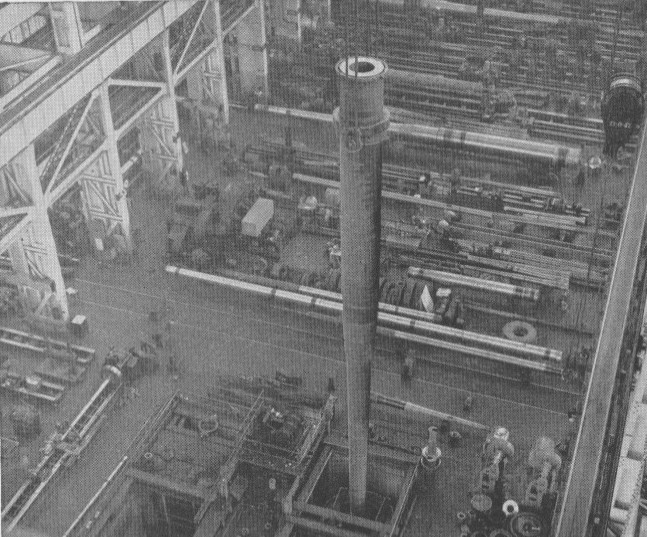
Gun Pit
- A lined hole into which a gun barrel is lowered to assemble or disassemble additional components such as a liner. With the barrel in place, heat is applied to the outside of the barrel while cold air or water is pumped through the liner. The result is that the barrel expands while the liner contracts, thus creating a small clearance around the liner. The liner can then be inserted or extracted from the barrel by hydraulic jacks. Liners are usually coated with graphite in an effort to ease assembly and disassembly. See Tom Scott Video for details on how Gun Pits were used to manufacture a built-up gun.
- British - An assembly station for large-caliber gun mountings. These allowed the entire mounting including the turret stalk to be assembled and static tested before it was disassembled and sent to the shipyard for reassembly onto the ship.
- A depression or opening on the gun deck into which the breech end of the weapon is lowered when the gun is raised to high elevations. This allows the trunnions of the gun to be mounted lower, thus lowering the overall height of the mounting while still allowing for high gun elevations.
- Land Artillery - An excavation in the ground used to position artillery guns so that they are protected from enemy fire.
Hangfire and Misfire - A hangfire is when there is an unexpected delay between when the trigger is pulled and the gun actually fires. This may be due to a slow burning primer, or, for bag guns, the powder bag may have been loaded backwards or it may have become crooked during loading, so there is a delay while the fire burns from the back of the bag to where the ignition pad is located. A misfire is when there is a complete failure to fire. It is impossible to tell a hangfire from a misfire until the gun breech is opened and the ammunition examined. For bag guns, an ember on the powder bag might smolder for a long time, so it is common practice to wait for 30 minutes before opening the breech.
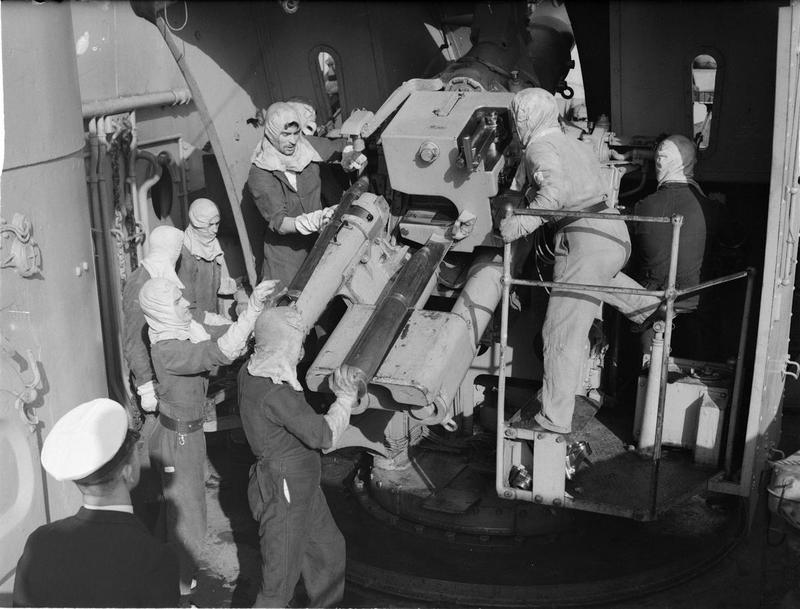
Holding down clip - These were metal brackets attached to the rotating structure of a turret that hooked around the roller path foundation. They were designed such that if the turret was to start to come out of the roller path, the clips would hit against the bottom of the roller race foundation and stop the turret from upsetting. Also known as Turntable Clips by the Royal Navy. See "Do turrets really fall out if a Battleship capsizes?"
S.A./Q.F. Guns - Many British cartridge guns of the World War II era could be operated in either the Semi-Automatic (S.A.) mode or in the Quick-Fire (Q.F.) mode via the S.A./Q.F. selection lever. In the Semi-Automatic mode, the gun breech opened automatically after firing to eject the expended casing as described above. In the Q.F. mode, the casing was ejected by manually actuating the breech lever. The reason for the Q.F. mode was for training purposes when using drill rounds. As the gun does not actually fire, the breech worker must eject the ammunition manually in order to allow the next round to be loaded.
Steel Choke - Refers to a type of flaw found in British guns of the late 19th and early 20th century. "Choke" is an allusion to a type of shotgun barrel that has had the muzzle deliberately altered in size and shape in order to give a more desirable pattern spread. As the British started to use larger castings for their guns during the late 19th century, problems arose caused by the uneven cooling of the metal. One of these problems was that of the inner A tube closing in near the muzzle and then cracking. This was a result of longitudinal stresses in the tube being concentrated at the foremost locating shoulder. Various makeshift arrangements, including such things as cannelured rings to support the castings, improved the situation somewhat, but the problem was never really corrected until the introduction of a slow taper fit between the inner A and A tubes and changing the position of the locating shoulders of the A tube well back so as to better distribute the stress patterns. The later versions of the 13.5 in/45 (34.3 cm) Mark V were the first guns built with this solution. A similar "steel choke" problem was found on many older gun designs after prolonged firing. As in most guns, the continual drag of the projectile driving bands caused the liners of these guns to be gradually stretched forward. The resulting projection at the muzzle could be simply cut off, but in addition the liners began to form a ridge in the bore near the shoulders of the outer A tube. This ridge, sometimes known as "copper choke" as it tended to accumulate copper from the projectile driving bands, narrowed the bore and could cause enough drag to initiate the projectile fuze, with the result that a premature detonation would occur either within the bore or shortly after the projectile exited the muzzle. While this ridge could be filed down, the only permanent solution was to fit the guns with a new liner having a different arrangement of the internal shoulders and rifling.
Torpex - "Torpedo Explosive" used by the USN during World War II. Torpex is composed of 42% RDX, 40% TNT and 18% powdered aluminum.
Turret Centering Pin - A large steel pin used to lock the turret on the centerline. These pins are used in special holes in the turret floor. When the turret is trained to be exactly on the centerline, these holes should then line up with similar holes in the top of the barbette. The pins are then placed into the holes to lock the turret in place. These pins thus prevent any motion of the turret due to rough seas and thus eliminate strain on the turret training mechanism. Usually there are one or two pins for each turret. The pins would be removed when readying the turret for action.
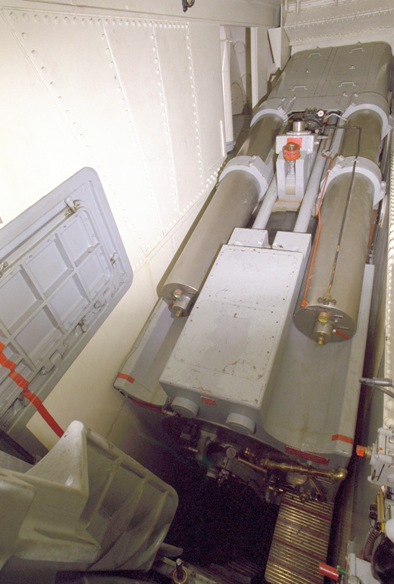
Yoke Locking Device - On USN guns, a mechanical assembly is used to lock the gun carriage, which remains stationary during firing, to the yoke, which moves with the gun barrel in recoil. Like the Turret Centering Pin, the Yoke Locking Device is used during non-firing periods to prevent motion of the gun barrel due to rough seas and thus eliminates strain on the gun recoil and counter-recoil cylinders. The Yoke would be unlocked before firing the gun. In the USN, the Yoke Locking Device had a safety link which was designed to snap should the gun be fired with the Yoke locked. The safety link was designed to fail before the gun was damaged.
ACTH - Arbitrary Correction To Hit. Empirical correction, based upon an analysis of previous firings, in range or deflection to compensate for indeterminate errors in the fire control solution.
Admiralty Table - British term during the mid-twentieth century for analog computers used to calculate firing solutions.
Amatol - An explosive mixture of ammonium nitrate and TNT often used in depth charges.
Angle of Fall - The angle with respect to the horizontal that a projectile attains at the end of its ballistic flight. Horizontal is defined as 0 degrees and vertical as 90 degrees.
Angle of Obliquity - The angle at which a projectile hits a plate of armor. Perpendicular, with the axis of the projectile at right angles to the surface of the plate at the point of impact, is defined as being 0 degrees.
Armor Penetration Definitions - The ability of an Armor Piercing projectile to penetrate armor is defined as follows:
- Rejected - The projectile fails to penetrate the plate.
- Partial Penetration - For hits of less than 45° obliquity, the forward half of the shell penetrates the armor while the rear half is rejected. For hits over 45° obliquity, the nose and upper body are rejected while the broken lower body penetrates. This usually means that the projectile will not explode or will have a low-order detonation, but it will still inflict splinter damage on whatever is behind the armor plate.
- Holing Limit - The maximum thickness of face hardened armor plate that can be damaged by a particular AP projectile. The projectile itself is rejected, but a plug of armor, usually of the diameter of the striking projectile, is pushed into the ship.
- Naval Limit - The maximum thickness of armor where at least 80% of the projectile penetrates. Usually this means that the projectile is broken up and will probably not explode, but it will still inflict splinter damage on whatever is behind the armor plate.
- Effective Limit - The maximum thickness of armor a projectile will penetrate relatively intact and still explode as intended.
Auto Control or Automatic Control - USN terminology meaning that the guns are being pointed at the target via data transferred electromechanically from the fire control computer (rangekeeper) system without manual input. See "Local Control" below.
Balloting - Any transverse motion of a projectile as it travels down the gun barrel. This motion can damage the projectile and/or the barrel.
Base Slap - When an armor piercing projectile hits an armored plate at an angle, there is a tendency for the shell to "yaw" or tilt as it pierces the plate. This tilt, if large enough, can result in the end of the shell - the base - hitting against the edges of the shell hole. The impact can cause the shell to break up and thus not detonate properly. Base slap also refers to when a shell hits a plate at such a large angle of obliquity that it starts to ricochet rather than penetrate. As the nose of the projectile bounces off, the base of the shell slams down onto the armor plate, which again can cause it to break up or detonate prematurely. See "Hammer Action" below.
Batten Board - This is a screen used for bore-sighting guns when a point target is not available. The board is set up at a specific distance from the gun or, as can be seen on the adjacent photograph, attached at a specific point on the gun barrel. On the screen there will usually be at least four points, one for the bore sight, one for the trainer's sight, one for the pointer's sight and one for the sight checker's sight. These points are marked at exactly the same distance from each other that they are on the gun being boresighted. On the batten board in the picture at right, the long vertical stripes were used to adjust the gunsights such that they remained in parallel with the barrel as it elevated. See "Bore Sighting" above.
Battle Ranges - The gun ranges at which navies expected to fight grew dramatically during the first half of the twentieth century. By 1900, most navies considered 1,000 yards to be the maximum range at which battles would be fought, although the 1898 Battle of Santiago during the Spanish-American War was fought at ranges up to 9,500 yards. In 1903, the US Navy thought of 3,000 yards as being the probable battle range. On the other side of the Atlantic in that same year, during tests carried out on HMS Venerable, British Admiral Sir Reginald Custance remarked "It is practically useless to open fire at ranges beyond 4,000 yards, and 8,000 yards is a ridiculous and impossible range at which to fight." Most of the major naval battles in 1905 during the Russo-Japanese War took place at ranges between 3,000 and 9,000 yards. A British naval observer of those battles, Capt. William Pakenham, concluded that superior British gunnery should allow fire to be opened at 20,000 yards and that 10,000 yards would be seen as close range. However, in 1905 the famous battleship HMS Dreadnought was designed to fight at 6,000 yards. By 1907, US battleships were being designed to fight at 8,000 to 10,000 yards. In December 1910 the Chief of the US Bureau of Ordnance was quoted in Brassy as stating that 12,000 yards was the maximum battle limit as "at 15,000 yards all or nearly all of the actual hull of the [target] was below the horizon." This referred to the view from turret gunsights; a spotter 90 feet up could see nearly twice as far. In 1911 the battleship USS Delaware (B-28) was able to repeatedly hit the obsolete USS San Marcos (ex-Texas) at 16,000 yards by utilizing such a spotter technique. In 1914 the British considered that "very long range" fire would commence at 15,000 yards for ships with 13.5" guns and at 13,000 yards for ships with 12" guns. However, at the Battle of Dogger Bank in January 1915, British ships opened fire at ranges of about 20,000 yards and were able to score hits even though their range finders were inaccurate at any range over about 15,000 yards. The USS South Dakota (BB-49) class of 1918 was designed for battle at 18,000 yards or more and when USS North Carolina (BB-55) was designed in the mid-1930s, she was expected to open fire at 24,000 yards.
BuOrd - USN Bureau of Ordnance. The Bureau of Ordnance and Hydrography was established on 31 August 1842 and changed to the Bureau of Ordnance (BuOrd) on 5 July 1862. The Bureau of Ordnance was abolished on 18 August 1959 when its functions were transferred to the Bureau of Naval Weapons (BuWeps). BuWeps was replaced by Naval Ordnance Systems Command which was established on 1 May 1966. This command and the Naval Ship Systems Command were combined to become the Naval Sea Systems Command which was established on 1 July 1974.
CEP - Circular Error Probable. Although a friend of mine insists that it really stands for "Circle of Equal Probability." Half of the data points fall within a circle of this radius centered on the MPI (or target, depending upon the the subject), half lie outside of this circle. For example, for an eight shell salvo, the CEP would be the radius of the circle containing the four shells that impacted closest to the MPI.
Collective Fire - When the whole battery of a single ship, which may consist of more than one caliber, fires at the same target.
Concentration Dial or Range Clock - In many ship photographs taken between about 1916 and 1940, there are what appear to be large clocks on the front and rear superstructures or masts. These are actually devices to tell the other ships in the formation at what range that ship is firing at. Together with Declination Marks (see below), these mechanisms allowed the other ships in the formation, whose view of the target may be obscured by fog, gun smoke or funnel smoke, to have their guns at the proper elevation and bearing when their view becomes unobstructed. This greatly reduced the time needed before they were ready to fire. The introduction of radar and better ship-to-ship communication methods in the late 1930s eliminated the need for these devices and they were removed from most ships by the start of World War II or shortly thereafter. For the concentration dial shown here, the small hand represents the range in thousands of yards, with 0 = 10,000 yards and 9 = 19,000 yards. The big hand represents range in hundreds of yards.
Concentration Fire - When two or more ships fire on the same target.
Continuous Fire - Firing is not stopped for spots or corrections. Usually applies only to ships having automatic control of guns or when the target solution is considered to be exceptionally good, such as when the target has been repeatedly hit by previous salvos. See "Rapid Fire" and "Slow Fire" below.
Continuous Fire, Rapid - Each gun in each turret or at each position fires when loaded and ready without waiting for the other guns.
Cook-off - Unintended firing of a weapon. A gun barrel becomes very hot after a prolonged period of firing. This heat can cause propellant in the firing chamber to become hot enough to spontaneously combust and thus unintentionally fire the weapon. This is one of the reasons why many automatic weapons are "bolt open" designs that do not chamber a round until after the trigger mechanism is activated.
Copper Choke - Most rifled guns of the nineteenth and twentieth centuries used projectiles having copper driving bands. When fired, copper rubbed off these bands will form deposits on the rifling of the gun barrel. These deposits can build up over time as the gun is fired and will narrow down the bore. The increased friction caused by this narrowing - "choking" - will slow down subsequent projectiles and thus increases the barrel pressure, often to dangerous levels that can damage or split the barrel. Most navies developed a procedure of regularly cleaning the barrels with wire or pisaba brushes in order to remove these deposits. See "Fouling" and "Steel Choke" below.
COTS - Commercial Off The Shelf. Using existing components and technology rather than developing new ones.
CTL - Constructive Total Loss. Something so badly damaged that it is uneconomical to repair it.
Cue Balling - One of the major "sailor alts" (see below) used to increase the rate of fire of 8 inch (20.3 cm) guns on US cruisers of the World War II period. This involved using the rammer at high speed to strike the projectile and bat it into the breech. This meant that the rammer did not have to extend and retract past the much shorter and thus faster acting powder bag ram position. This unofficial loading method increased the ROF of these weapons from the standard 3 RPM up to 5 or 6 RPM, a significant improvement. The fact that the gun crews were able to do this on a regular basis and not damage the mechanisms is a credit to the designers of the mountings, who over engineered them to be resistant to such abuse.
DAMS and DEMS - British designations meaning "Defensively Armed Merchant Ship," used during World War I, and "Defensively Equipped Merchant Ship," used during World War II. This terminology was an attempt by the British to circumvent those treaty provisions that allowed submarines to attack any armed merchant ship without warning.
Danger Space - That distance in front of the target, measured parallel to the line of fire, that the target could be moved toward the firing point, so that a shot striking the base (waterline) of the target in its original position would strike the top of the target in its new position. The flatter the trajectory, the greater the danger space. See "Hitting Space," below.
Declination Marks - Scales painted on a turret to indicate to other ships in the formation the direction in which the turret is pointing. See photograph of HMS Emperor of India at right. See "Concentration Dial" above.Deflagration - Very rapid combustion sometimes accompanied by flame, sparks and/or spattering of burning particles. Deflagration, although classed as an explosion, generally implies the burning of a substance with self-contained oxygen so that the reaction zone advances into the unreacted material at less than the velocity of sound in the material. In this case, heat is transferred from the reacted to the unreacted material by conduction and convection. Burning rate is usually less than 2,000 meters per second.
Deflection - Lateral angular correction applied to target bearing to bring fire onto a target. Most targets move, so it is necessary to "lead" them so that the projectile will arrive at their future position. See "LOF" and "LOS" below.
Detonation, Low Order - The condition when a bursting charge does not fully combust or combusts inefficiently. This can be the result of a projectile being damaged when striking the target, such as when an AP projectile passes through armor.
Dispersion - The distance from the point of impact of a particular projectile to the MPI of the salvo. Dispersion in range is measured parallel to the line of fire and dispersion in deflection is measured at right angles to the line of fire. A Dispersion Pattern is the combining of all the impact points of a particular salvo.
Drift, Angular - The angle between the bore axis of a weapon and the target. See "LOF" and "Trajectory" below.
Drift, Linear - The lateral deviation of a projectile in flight caused by the rotation of the projectile. See "LOF" and "Trajectory" below.
Elevation - Moving a gun along its vertical axis.
Equal Section Charge - Propellant charge made up of a number of small charges equal in size. Making multiple small individual charges makes them easier to handle than one large charge. The number of sections used determines the muzzle velocity and range of the projectile.
Erosion - Wearing away of a bore due to combined effect of gas washing, scouring and mechanical abrasion. The greatest source of wear is from the propellant gasses, which corrode the rifling via heat and chemical action.
FCS - Fire Control System. This usually refers to all elements involved in pointing the guns at a target from the range finder to the rangekeeper to the elevating and training mechanisms for the guns themselves.
Feed - How ammunition is supplied to a weapon.
FKC - Fuze Keeping Clock. A simplified version of the British HACS. See HACS essay in the History and Technology Section for further information.
Flare-back - When a gun is fired, smoldering remnants and unburned propellant or propellant gasses can be left in the chamber. When the gun breech is opened, the sudden infusion of oxygen can cause these to ignite, sending flame back into the gun housing. Many large caliber weapons used a purging system which injected air or nitrogen gas into the chamber shortly after the gun was fired in order to extinguish and expel such particles. In movies or pictures of USN 16 inch (40.64 cm) guns, this purging can be seen as a small puff of smoke that is emitted a few seconds after the gun fires.
Fouling - Deposits of metal in the bore of a gun from the jackets or rotating bands of projectiles. Sometimes also known as "copper choking." In the days of black powder guns, this was also the term used for the residue left in the gun barrel from unburned gunpowder.
fps - Feet per second.
GFCS - Gunfire Control System.
Gun Index / Turret Efficiency - Guns in multiple mounts always lose efficiency as compared with the same number of guns in single mounts. This is a factor of reduced rate of fire, handling awkwardness, interference between guns, fire control, salvo problems and so forth. To account for these factors, there is a gun-index rule of thumb that goes like this: A twin mount is roughly 1.75 times as effective a single mount, a triple mount is roughly 2.5 times as effective as a single mount and a quadruple mount is roughly 3.125 times as effective as a single mount.
HACS - High Altitude Control System. A series of British analog anti-aircraft fire control computers and directors of the late 1920s - 1940s period. See HACS essay on the History and Technology Section for further information.
Hammer Action - When a shell hits armor plate at a large angle of obliquity (usually about 25 to 30 degrees) there is a tendency for the shell to bend or whiplash as the nose of the shell abruptly slows down before the base does. This can cause the shell to break up, detonate prematurely or fail to penetrate. The name comes from the similarity of using a hammer to hit a nail head at an angle, rather than straight on. The nail usually gets bent over, rather than being driven into the wood. See "Base Slap" above.
Hitting Space - The distance behind the target, measured parallel to the line of fire, that a projectile striking the top of the target will strike the horizontal plane through the base (waterline) of the target. It may also include a distance in front of the target within which impacts are likely to produce underwater or ricochet hits upon the target. In other words, the hitting space is the distance between the point where a shell falling short of a target will start to inflict damage and the point at which a shell falling long of a target will stop inflicting damage. The greater the angle of fall, the smaller the hitting space. At long ranges, danger space and hitting space are about the same size, but at short distances the danger space is larger than the hitting space. See "Danger Space" above.
HSMST - High Speed Maneuvering Surface Target.
Inclined - During an inclination test, a set of standard weights are run on rails across the beam of the ship. The amount of tilt (inclination) caused by moving the weights a certain amount can be used in calculations to determine how much the ship weighs. Various other factors - such as weight distribution fore and aft - can also be determined by moving the weights back and forth.
Indirect Fire - Firing at a target that cannot be seen. Usually refers to shore bombardments.
IS or ISE - Initial Salvo Error. The distance by which the first salvo missed the target.
Killer Tomato - Pictured at right, this is a large orange floating balloon that is used as a target during naval live fire exercises for guns. Other available inflatable targets include the "Killer Lemon" (yellow floating balloon), the "Killer Banana" (yellow towed target) and the "Bogie Blimp" (aerial balloon AA target).
Ladder Salvo - Also called "Ranging Salvo." When a ship is firing at a target and isn't quite sure of the range, what the gunnery officer will often do is elevate each gun or group of guns slightly differently. This makes each shell land a little farther along than the last one. By watching to see which shell hit or landed closest to the target, the range can be determined more accurately. During the early part of World War II, the procedure used by the new US battleships was to fire all nine guns as a ranging salvo, a typical pattern being one group (three guns from one turret) at 200 yards (180 m) up from the initial range estimate, one group at 200 yards (180 m) down and one group at 400 yards (370 m) down. There was also a timing difference between groups to avoid confusion between the shell splashes. Once a bracket had been obtained, thus indicating the correct range, the ship would then switch over to rapid fire, with the guns firing as they were ready.
Laying - As in "Laying the Guns." Setting the elevation and train of the guns such that the shells will land on target.
Lead Angle - The difference between LOS and LOF is referred to as the "Lead Angle," as illustrated in the adjacent sketch.
Local Control - Guns are fired using only their co-located telescopes or open sights and do not use director or remote control. Values of range, deflection, and fuze settings are determined at the guns.
Loose Ammunition
- Individual rounds for a gun that is clip or magazine fed. Ammunition for such weapons is usually supplied loose in boxes and needs to be loaded into the magazine or clip before it can be fired.
- Term used for ammunition for older guns where the charge (propellant), projectile and wadding were all supplied separately.
LOS - Line of Sight. The direct line between your weapon and the target's present position.
Measurement Units
- Nautical Mile - Until relatively recently, a nautical mile was defined by Britain to be exactly 6,080 feet (1,853.184 m) long while the USA defined a nautical mile as being 6,080.2 feet (1,853.249 m) long. In 1929, the International Extraordinary Hydrographic Conference defined an "International Nautical Mile" as being exactly 1,852 meters (6,076.115 feet) in length. This standard was adopted by the USA in 1954 and by Britain in 1970. Under any of these standards, a nautical mile has been traditionally rounded off by English-speakers to 2,000 yards (1,828.8 m). When one reads in a British or USA publication of something being ten nautical miles away, it usually means a distance of 20,000 yards (18,288 m). A cable is normally defined as being one-tenth (0.1) of a nautical mile, although there is no internationally recognized definition.
- Inch to Centimeter Conversions - From 1893 until 1959, the United States of America defined one meter to be exactly equal to 39.370 inches. This meant that the USA inch was equal to 2.54000508 cm. During that same period, Great Britain defined an Imperial inch to be equal to a 1/500,000 part of Earth's polar diameter, which meant that an Imperial inch was equal to 2.5399772 cm. In 1959, both nations adopted the "international inch" standard which defined one inch to be exactly equal to 2.540 cm and thus 1 meter was now 39.37007874 inches. At this same time, the US "mile" measurement changed to the new system, but "statute mile" remained at the old standard in order not to mandate changes to every US Geological Survey Map ever made. Thus, a "US mile" per the International Standard is still 5,280 feet (1,609.344000 m) long but a "US statute mile" is 5,280 "survey feet" (1,609.347219 m) long. On my datapages, the inch to metric conversion and vice versa is always given in international inch units.
- Weight - In the USA and Britain, the displacement of a ship or the weight of a major ship component such as a turret was usually stated in "long tons" which is a measurement unit equal to 2,240 lbs. (1,016.047 kg). Other nations generally used "metric tonnes" for these purposes, which are 1,000 kg or 2,204.623 lbs. each. On my data pages, weights given in "tons" are long tons, while those given in "mt" are metric tonnes. It may be assumed that one British "Imperial" pound is essentially equivalent to one USA "avoirdupois" pound at any time after 1883, as the differences between them were trivial (about 1/10,000,000), although they were not officially made exactly equal until the United Kingdom approved the Weights and Measures Act of 1963.
MPI - Mean Point of Impact. The statistical midpoint of a salvo of projectiles. For example, if a circle is drawn around the shell splashes created by a single salvo, then the MPI would be the center point of that circle.
mps - Meters per second.
Muzzle Energy - The kinetic energy of a projectile as it leaves the muzzle of the gun. This is a product of the projectile's mass and velocity as calculated by the formula: ME = 0.5 * Mass * Velocity * Velocity. Muzzle energy should not be confused with momentum, which is calculated with the formula: Momentum = Mass * Velocity.
Muzzle Flash - Fireball seen when a gun fires. This glare is primarily the result of the ignition of unburned propellant gases as they exit the muzzle of the gun and mix with atmospheric oxygen. See Muzzle Flash essay in the History and Technology Section for further information.
NGFS or NGS - Naval Gunfire Support.
NSFS - Naval Surface Fire Support. Includes surface-to-surface missiles and other ship-borne ordnance as well as gunfire.
Offset Firing - A live firing exercise where a deflection error is entered into the calculations such that the projectiles land a predetermined distance to the left or right of the target ship.
OP - Ordnance Pamphlet. USN Bureau of Ordnance (BuOrd) document. Ordnance Pamphlets contain detailed information describing the operation and maintenance of ordnance equipment. A separate Ordnance Pamphlet is issued for each unit of ordnance equipment, such as guns, turrets, directors, etc. In addition, other Ordnance Pamphlets contain more general instructions or such data as range tables, nomenclature lists, scientific principles, etc.
OrdAlt - Ordnance Alteration. USN Bureau of Ordnance (BuOrd) document describing a change to an existing weapon, ammunition, mounting, etc. See "Sailor Alt" below.
Ordinate - Any point along a projectile's ballistic path. "Maximum Ordinate" is the highest point (apogee or summit) that the projectile attains during its flight.
Optronic - A combination of the words OPtical and elecTRONIC. Usually refers to an optical gunsight which has some means of computer-assisted aiming.
Parbuckling Gear - As used in USA ships, a projectile moving system using powered capstans and ropes. "Parbuckling" is the process of moving the projectiles out of stowage and onto the shell hoists.
Pattern - The pattern of a salvo in range is that distance measured parallel to the line of fire between the shot that lands at the greatest distance from the firing ship and that that lands at the shortest distance, excluding wild shots. The pattern of a salvo in deflection is the distance measured at right angles to the line of fire between the shot landing farthest to the right and that landing the farthest to the left, excluding wild shots.
Pisaba Brush - Gun barrel cleaning device made with bristles from a type of palm frond. Usually mounted on a long pole or has ropes attached to each end so that it can be pushed and pulled through the gun barrel.
POH - Probability of Hit.
Proof or Proofed - As in "proof
test."
1) After a gun is manufactured and has
passed visual and non-firing tests, it is taken out to a gun range where
it is fired with charges well above the maximum service charge. A
gun having passed these tests is said to have been "proofed" or "proof
tested." Proof testing for US Army cannons today consists of firing
three standard rounds through the gun and then one "super slug."
The standard rounds subject the cannon to typical stresses, while the super
slug inflicts more severe stresses on the cannon than it would normally
experience during its service life.
2) When ammunition is manufactured, a
representative sample of each lot is fired to determine if it meets specification.
Pyro - USN slang term for SPD propellant.
Range Clock - See "Concentration Dial" above.
Range, Gun and Navigational
- Navigational Range is the geometric distance between the firing ship and the target at the moment of firing. This is measured by the ship’s optical and/or radar rangefinders when firing at targets those instruments can "see." When firing at a land target using aircraft or Shore Fire Control Parties for spotting, the Navigational Range is determined by map coordinates of the target and the ship’s location as calculated by the Navigator.
- Gun Range is the range set on the gunsights to obtain a hit and is the output of the ship’s fire control computer. As the movements of both the firing ship and the target affects the point of impact, the Gun Range and the Navigational Range are seldom the same.
Range, Maximum - A gun does not always achieve its maximum range at an elevation of 45 degrees. This is because air friction will always alter the ballistic path that a projectile takes. For example, when large caliber guns with high muzzle velocities are fired at elevations greater than 45 degrees, their projectiles pass through thinner, more rarefied air. This reduces the air's total resistive effect on the projectiles throughout their flight time, allowing them to achieve greater ranges as a result.
Range, Slant
1) The distance in a straight line to
an airborne object. In other words, the length of the hypotenuse
of a triangle formed by the horizontal and vertical distances to the object.
2) The maximum distance a projectile can
travel before it reaches its highest altitude (apogee). This is useful
in gauging the performance of AA weapons as it represents the reasonable
maximum range that an aircraft or missile can be engaged.
Range Finders, Optical - There are two basic types of optical rangefinders used on ships, coincidence and stereoscopic. The coincidence type splits the view into two separate sections, usually one above the other. The observer adjusts the rangefinder controls so as to move the two views into alignment in order to get the correct range. Coincidence rangefinders require an easily discernible line on the object being ranged in order to accurately measure the distance. The stereoscopic type works like binocular vision. If you do not have your eyes focused correctly, then the object you are looking at is blurred or doubled. When your eyes are focused correctly, the object appears clear and you have a good idea of the distance to that object. Stereoscopic rangefinders operate in a similar fashion. There are two separate images, one for each eye, that must be blended together in order to get the correct range. In USN systems, there were small diamond marks on the borders that were "moved" forwards or backwards until they appeared to be in focus at the same range as the target. Stereoscopic rangefinders generally give better results and are harder to "spoof" than coincidence rangefinders, but they require special aptitudes and a high degree of concentration on the part of the operator.
Rangekeeper - USN term for analog computers used in the first half of the twentieth century to calculate firing solutions. Replaced by simply "computer" in modern times.
Rapid Fire - The director fires whenever a certain number of turrets are ready. In case of rapid fire guns this is synonymous with continuous fire. See "Slow Fire" below.
RCS - Radar cross section. The measure of a target's ability to reflect radar signals in the direction of the radar receiver. The larger this value, the more energy that is reflected back to the radar receiver.
Ready-use Ammunition - Ammunition stored close to a gun instead of in a magazine. For larger guns located in open mounts, the rounds may be stored in bullet-proof steel lockers or racks. Many smaller guns have the ready rounds clipped to the inside of the gun shield for easy access.
Rocking Ladder - "Walking" the point of aim back and forth across the target, thus allowing for small errors in the firing solution. Often used for rapid fire and automatic weapons.
rpmpg - Rounds per minute per gun. A way of describing the rate of fire of each individual gun in a multi-gun mounting.
Run-out - The process of returning guns to battery after they have fired and recoiled. This term originates from the days of muzzle loading cannon where the cannons had to be withdrawn into the ship to be loaded and the crews had to then manually move the cannon back out the gun ports before they could be fired. Most large caliber weapons designed since 1880 utilize hydraulic and pneumatic run out systems although many smaller weapons such as machine guns use springs.
Safety Rails - On many warships with light, manually worked automatic weapons such as the 20 mm Oerlikon, there will be a railed structure surrounding the weapon. These are used to prevent the gun from being pointed in certain directions and thus prevent the gunner from accidentally firing into the ship itself. See "Wooded" below.
Sailor Alt - Unofficial USN term used to describe an unauthorized change to standard practice. See "Cue balling" and "OrdAlt" above.
Salvo - When two or more guns are fired.
Salvos, Half and Double - In some action accounts of British warships, there are references to "half salvos," "double salvos" and "broadsides." In this context, when referring to a ship armed with multiple two-gun turrets, a "half salvo" was when the ship simultaneously fired one gun from each turret. A "double salvo" was when one gun from each turret was fired, followed a few seconds later by the other gun. A "broadside" was when all guns were fired simultaneously. Half salvos were generally used for ranging purposes while double salvos were used once the range was known. Double salvos had the advantage of reducing shell interference at the cost of some lateral dispersion caused by the turret rotating under the off-axis force.
Shell Weight - Although rarely noted, any shell will have some weight tolerance to allow for manufacturing variances. For example, the USN 16" (40.6 cm) AP Mark 8 "Super Heavy" had a nominal weight of 2,700 lbs. with a tolerance of +/-7.5 lbs. (1,225 kg +/-3.4 kg). Dye bags, nominally weighing 1.5 lbs. (0.68 kg), were allowed to be as large as 3.0 lbs. (1.36 kg) in order to bring underweight projectiles to within tolerance limits.
Siacci Method - A method of determining approximate ballistic performance developed in the late 1880s by Cornal Francesco Siacci of Italy. This method is useful only for low-angle trajectories (<15 degrees) and is commonly used today for calculating the performance of rifle-caliber bullets. The method reduces the calculations for a low-angle trajectory to an easily tabulated quadrature giving distance, time, inclination (flight path angle) and altitude (height) in terms of a "pseudo-velocity."
Slow Fire - Firing a salvo only after the one before it has landed and its spot has been applied to the firing solution. See "Rapid Fire" above.
Spall - Fragments broken from either surface of a barrier. For example, fragments broken from an armor plate as the result of projectile penetration, impact or detonation against the plate.
Straddle - When a salvo lands on each side or all around the target. This indicates that the firing solution is correct and thus the next salvos may be fired without waiting for spot correction.
Star gauge - A simple measuring tool used for large caliber guns to determine the amount of liner wear at the start of the rifling in front of the forcing cone. This measurement is used to calculate the amount of liner life remaining.
Striking Angle - The angle at which a projectile hits a plate of armor. Perpendicular, with the axis of the projectile at right angles to the plate, is usually defined as being 90 degrees. With this definition, the striking angle is then the reciprocal of the angle of obliquity. In other words, if the striking angle is 50 degrees, then the angle of obliquity is 40 degrees.
Superelevation or Super Elevation - The angle the gun must be elevated above the line of sight in order to compensate for the effect of gravity acting on the projectiles in flight. See "Trajectory" below.
Swedish Additive - A mixture of titanium dioxide and wax that greatly reduces barrel wear. This mixture was extensively used aboard the US Iowa class battleships during their last activations where it was credited with at least quadrupling the liner life.
Synchronizing Time - The length of time required for a gun mounting to move to the elevation and train positions being sent from fire control.
Tachymetric - Literally means speed measurement, but in the British Royal Navy of the World War II era this word was used to describe a fire control system that automatically predicted the future position of an aircraft target in three dimensions.
Target Salvo - When the target's range is accurately known, all guns are fired at the same elevation, which makes all the shells land close together. This greatly increases the chance of a hit.
Tip-Off Angle - The tilt of a projectile away from the axis of the gun barrel as the projectile exits the muzzle. When the bourrelet of a projectile clears the gun muzzle, the front of the projectile is no longer receiving support from the gun barrel while the driving bands continue to support the rear of the projectile. This means that the force of gravity will try to rotate the projectile about its center of mass, which causes the nose to drop slightly. This tilting process continues as the projectile emerges from the barrel until the time that the driving bands exit, at which point the projectile is no longer receiving any support from the gun barrel. The result is that the axis of the projectile is no longer in parallel with the axis of the gun barrel. In other words, the nose ("tip") of the projectile is slightly askew ("off") from the center or axis of the gun barrel while the base of the projectile is still aligned with it. Asymmetrical differences in friction around the circumference of the muzzle (caused by erosion, thermal deformation or balloting) and strong cross winds can also produce tip-off forces. Tip-off angles are generally small, but they contribute to round-to-round dispersion.
TNT - Tri-nitro-toulene.
Torching - The burning of the combustible components of the residual gases in the cartridge case following extraction and exposure of the case and gases to oxygen. Hot surfaces on the cartridge case having temperatures in excess of 1,400 degrees F (760 degrees C) can cause ignition of the residual gasses.
Train
1) Moving a gun or mounting along its
horizontal axis. Also called "traverse" or "traversing."
2) A line of gunpowder leading to an explosive
charge within a shell. Usually called "explosive train."
Trajectory - The path followed by a projectile in flight.
Ultimate Battery - During World War II, the USN made extensive plans as to what kind and how many of various weapons would be carried by each class of ship. This planned weapons set for a particular class of ship was known as its "ultimate battery." Due to shortages or changes in other areas, such as increased electronics, the "ultimate battery" was often changed or not reached during the war.
Ward-Leonard System - An adjustable speed drive for electric motors. This system controls the DC voltages to the armature and the magnetic field strength with a simple algorithm, in which the desired torque and the magnetizing field strength served as command inputs. This system not only furnishes a very flexible and rapid control of heavy machinery, but also eliminates the power loss associated with the use of rheostats.
Wear Gauge - A truncated cone used on smaller guns to determine the liner life remaining. This is inserted into the breech end of the weapon.
Windage - The gap between the outer surface of a projectile and the surface of a smooth-bore gun. Projectiles must be slightly smaller than the gun bore in order to allow them to be easily loaded. Windage is not normally used to describe rifled weapons, as it is considered that the projectile driving band fills the gap.
Wild Shot - A projectile that lands abnormally far in deflection or range from the MPI.
"Wooded" and "Wooding" - When a gun or gun sight is pointed in a direction where its LOF or LOS is blocked by the ship's structure. This term comes from when ships were built of wood.
Zig-zag salvo - British gunnery term. When previous salvos have landed to the left or right of the target - known as being "out of line" - or when no straddle was obtained, the British surface gunnery procedure was to fire the next two salvos 100, 200 or 400 yards (90, 180 or 360 m) apart in an attempt to obtain a straddle and thus ascertain the correct range and bearing.
From "Ghostrider One" by Gerry Carroll, published by Simon & Schuster © 1993:
Battleships - Even though these great warships do not figure in this novel at all, I can't resist commenting on them. From the earliest days of naval warfare, even the dumbest commanders have known that the thing which is the number-one most important gotta-have-it asset in a fight is weight of metal on the enemy. You can screw up the tactics, but if you've got the biggest guns and the heaviest shells coming down on the bad guys accurately, you will probably win. There are all sorts of annoying exceptions to this rule, but it still holds most of its water.
The BBs were the rulers of the sea up until the Japanese took their little trip to Hawaii in 1941, then were supplanted by the carriers (out of sheer necessity since the American battleships had been abruptly turned into hazards to navigation). The battleships were relegated to a supporting roll and, except for getting dragged out of mothballs for every war we've had since World War II, were pretty much finished.
In the eighties, we recommissioned all four of our Iowa class battleships and deployed them around the world. They carried sixteen-inch guns and fired rounds weighing around 2,700 pounds apiece. The effect was like shooting an entire showroom full of Ford Escorts, packed with high explosive, about twenty-five miles. When the rounds hit, they made instant holes in civilization that were the size of tennis courts. I got to see the New Jersey fire a broadside at somebody in Beirut once, and I still haven't found the words to describe it.
This was also effective because the people who were fired upon immediately quit annoying their neighbors and repaired to their graves. The surviving terrorists went home for an underwear change and all was quiet for awhile.
The battleships have all been mothballed again now and it doesn't seem the same anymore. When one sees a battleship steaming along, one is seeing Navy and all that that meant through the centuries. There is no weapon on earth that will make a little tinpot dictator sit up and take notice like a battleship slowly cruising off his coast well out of pistola range with her guns trained on his presidential palace. It sort of gives him a little peek at his relative importance in the grand scheme of things. If that peek stops one firefight, however small, or saves one life, or ensures the fairness of one election, then the battleship has earned her keep.
But, since those things usually happen outside the Capital Beltway, and Dan Rather doesn't mention them, they matter not at all to the geniuses in Washington. Those events have no bearing on the next election, and every congressman knows that money to measure the effect of cow farts on the ozone layer is far more important than wasting it on a battleship. They're quite correct, too. It'll help next year, when the bill to teach cows to say "excuse me" comes out of committee.
13 November 2008 - Benchmark
18 March 2009 - Added link to USN "Nomenclature of Naval Vessels"
02 September 2009 - Added link to Britain 12"/50 Mark XIV datapage
16 September 2011 - Added link to Help Bulletin Board
22 June 2012 - Added a definition for Armor Thickness
04 November 2012 - Added to "Battle Ranges" definition
17 February 2014 - Redid photograph of HMS Emperor of India
28 July 2014 - Changed links to other Gun Data datapages
27 March 2015 - Added definition for Pyro, updated links to off-site pages
28 April 2015 - Added definitions for Loose Ammunition
20 July 2015 - Added definition for BCW
07 March 2016 - Minor corrections
07 May 2016 - Converted to HTML 5 format
25 July 2017 - Updated links
28 February 2018 - Minor changes
25 April 2018 - Fixed formatting problems
08 May 2019 - Added definition for zig-zag salvos
22 May 2020 - Added definitions for balloting and S.A./Q.F. guns
15 June 2021 - Updated link to Naval History and Heritage Command
07 November 2021 - Added Gun Pit definitions
31 January 2022 - Added remark by Admiral Sir Reginald Custance
05 March 2022 - Added definitions for Holding Down Clip and Turret Centering Pin
27 May 2022 - Updated links and moved Charge Assessment definition to Gun Data Part 2
03 August 2022 - Added to Mil definition
11 November 2022 - Added Amatol definition
09 July 2023 - Updated definitions for Navigational and Gun Ranges
21 August 2023 - Added data to "Gun Pit" definition
05 September 2023 - Added Yoke Locking Device definition
28 February 2024 - Added definition for Torpex
28 March 2024 - Added definition for shell weight
08 January 2025 - Corrected typographical error

